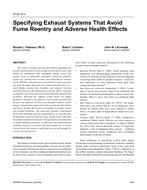Description
This paper provides general information regarding the need for good exhaust system design and discusses issues that should be considered when designing exhaust stacks and intakes, such as applicable standards, analytical methods, plume rise, architectural screens, and entrained air exhaust stacks. Whether conventional or entrained air exhaust systems are used, the paper discusses why exhaust specifications (i.e., stack height, volume flow, location, and exhaust velocity) should be based on the appropriate criterion, that is, ensuring acceptable concentrations at air intakes and other appropriate locations. Selecting an exhaust system based on simple geometric methods or an effective stack height specification alone is not sufficient to ensure an adequate exhaust system design. A quantitative approach is discussed to specify exhaust and intake designs that ensure acceptable air quality inside and around buildings. The approach includes wind-tunnel dispersion modeling and the establishment of concentration design goals based on emission rates, health limits, and odor thresholds of emitted chemicals. The approach was utilized for a simple building geometry to illustrate that mathematical methods can give excessively tall stack heights for an unobstructed roof and can give stacks that are not tall enough for a roof with obstructions.
Units: Dual
Citation: Symposium, ASHRAE Transactions, vol. 108, pt. 2
Product Details
- Published:
- 2002
- Number of Pages:
- 11
- File Size:
- 1 file , 1.5 MB
- Product Code(s):
- D-8971




